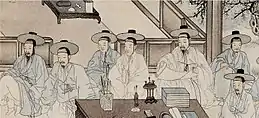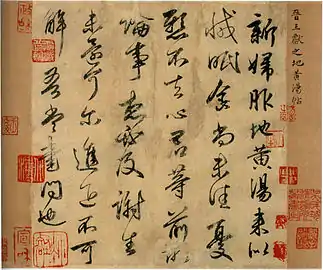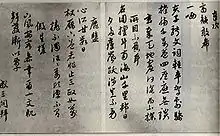Korean calligraphy
Korean calligraphy, also known as Seoye (Korean: 서예; Hanja: 書藝), is the Korean tradition of artistic writing. Calligraphy in Korean culture involves both Hanja (Chinese logograph) and Hangul (Korean native alphabet).
 |
| Part of a series on the |
| Culture of Korea |
|---|
| History |
| Korean calligraphy | |
| Hangul | 서예 |
|---|---|
| Hanja | 書藝 |
| Revised Romanization | Seoye |
| McCune–Reischauer | Sŏye |
 |
| Calligraphy |
|---|
Early Korean calligraphy was exclusively in Hanja, or the Chinese-based logography first used to write the Korean language. During the Goryeo and Joseon dynasties, utilitarian objects were often inscribed with calligraphy such as brush stands, padlocks, incense burners, porcelain, lacquer, and branding irons.[1] Even after the invention of the Korean alphabet Hangul in 1443, Korean calligraphers preferred Chinese characters as they saw it more prestigous. Hanja continued to be used as the official script until the late 19th century. This changed when both North Korea and South Korea, after their split, separately institutionalized Hangul as the official orthography of Korean. Today many calligraphers, particularly in South Korea, are experimenting with new styles of Hangul, which has become an important part of the larger practice of Korean calligraphy.[2]
History
Chinese calligraphy was introduced to Korea as early as the 2nd or 3rd century CE, and became popular in the 7th century. In the 8th century, Kim Saeng became known as the earliest Korean calligraphic master, producing work that was compared with that of master Chinese calligrapher Wang Xizhi.[3] In the 9th century, poet Choe Chiwon became known for his calligraphy both in his home country Silla and in the Tang Dynasty.[4]
The angular calligraphy styles of the early Tang masters, Yu Shinan, Ouyang Xun, and Yan Zhenqing, persisted in popularity until the 14th century, when the more rounded style of Zhao Mengfu came into vogue.[5] Korean calligraphy became increasingly formalistic in the years that followed.[6] Gim Jeong-hui (김정희, 金正喜, (1786–1856), also known as Kim Jeong-hui, is considered the greatest calligrapher in the Joseon dynasty, and he was also a scholar-official, painter, epigrapher, and practicing Buddhist. He was a master of many calligraphic forms but is most famous for Chusache, the bold, freeform style he perfected while in exile on Jeju Island.[7] He is known as the chusa style after his pen name 秋史, inspired by the ancient Chinese lishu script.
As the scholarly classes used Chinese characters, Korean calligraphy used hanja until the 1910–1945 Japanese occupation of Korea. Nationalist sentiment led to the popularization of the native hangul alphabet, and calligraphic works using hangul have since seen a revival, although hanja calligraphy is still popular today.
The Korean calligraphy is developing its own style, steadfastly. Fonts that are not square are being developed, considering jong-sung, or sound coming after the vowel.
Types
There are five major types of Korean Hanja calligraphy, which are derived from Chinese calligraphy.[2]
- Jeonseo (전서/篆書)
Jeonseo means seal script. Seal scripts are regularized script. It is noted for their uniformity of thickness, and space of vertical, horizontal, and curved lines. Thus, it is often use for seals and chops.
- Choseo (초서/草書)
Choseo means cursive or grass script. They are famous for its efficiency individual pen strokes. Extreme cursive script is not legible for most people because different characters may resemble each other when written in cursive script.
- Haeseo (해서/楷書)
Haeseo means block script. Block script characters are basically fit into a square space, with each character roughly the same size proportion. Chinese character often uses this font.
- Haengseo (행서/行書)
Haengseo means semi-cursive script. Semi-cursive script is a kind of character located between block and cursive script. It is legible for most people and quick to write and more practical.
- Yeseo (예서/隸書)
Yeseo means official script. Official Script is developed from seal script form. They are angular in appearance and highly legible compared to cursive or seal script.
The "four friends" of tools
The” four friends” means paper, brush, ink stick, and ink stone in Korean calligraphy. Those are called Munbangsawoo in Korean. In Korean calligraphy, traditional hanji made of Korean mulberry is used. It is well-suited for absorbing ink and reflecting its colors. For brush, animal hairs of same length are selected and made into straight and a sharply pointed tip. Ink stick is made by soot from burned trees and glue. A good ink stick has extremely fine particles. Finally, ink stone must be made from a firm stone which does not when ground by the ink stick, or jade. In addition to the four tools, calligraphy needs other items: a yeonjeok, a container of water, used for making ink with ink stick, boot tong, a container for holding brushes after being used, munjin, a long and flat paper weigh, and pilse, a bowl for washing the brush.[8]
Gallery
- Examples of Korean calligraphy
 Calligraphy by scholar-official Seong Sam-mun (1418-1456).
Calligraphy by scholar-official Seong Sam-mun (1418-1456)..jpg.webp) Korean mixed script calligraphy in a replica of the Hunminjeongeum Haerye (1446).
Korean mixed script calligraphy in a replica of the Hunminjeongeum Haerye (1446). Calligraphy by one of Korea's most celebrated calligraphists, Kim Jeong-hui (1786-1856).
Calligraphy by one of Korea's most celebrated calligraphists, Kim Jeong-hui (1786-1856). Korean calligraphy written in Hangul.
Korean calligraphy written in Hangul.
References
- Little, Stephen; Virginia, Moon (2019). Beyond Line: The Art of Korean Writing. Prestel. ISBN 07413351 Check
|isbn=value: length (help). - Brown, Ju; Brown, John (2006). China, Japan, Korea: Culture and Customs. Ju Brown. pp. 102–104. ISBN 978-1419648939.
- Chen, Tingyou (2011). Chinese Calligraphy. Cambridge University Press. p. 116. ISBN 978-0521186452.
- Choi, Yearn-hong (2016-07-08). "Choe Chi-won, great Tang and Silla poet". The Korea Times. Retrieved 2017-12-10.
- Woo-Yong, Kim (2009). "Korean calligraphy". Encyclopædia Britannica.
- Yi, Ki-baek (1984), A New History of Korea, Harvard University Press, ISBN 9780674615762
- Yu, Hong-june. "The masterful calligraphy of Gim Jeong-hui". Koreana. 15(3).
- "Calligraphy – the art of writing". AntiqueAlive.